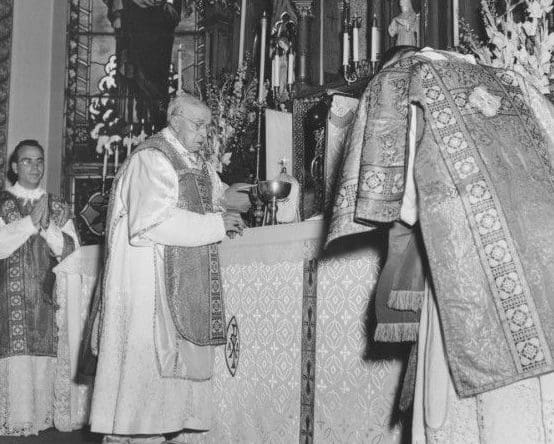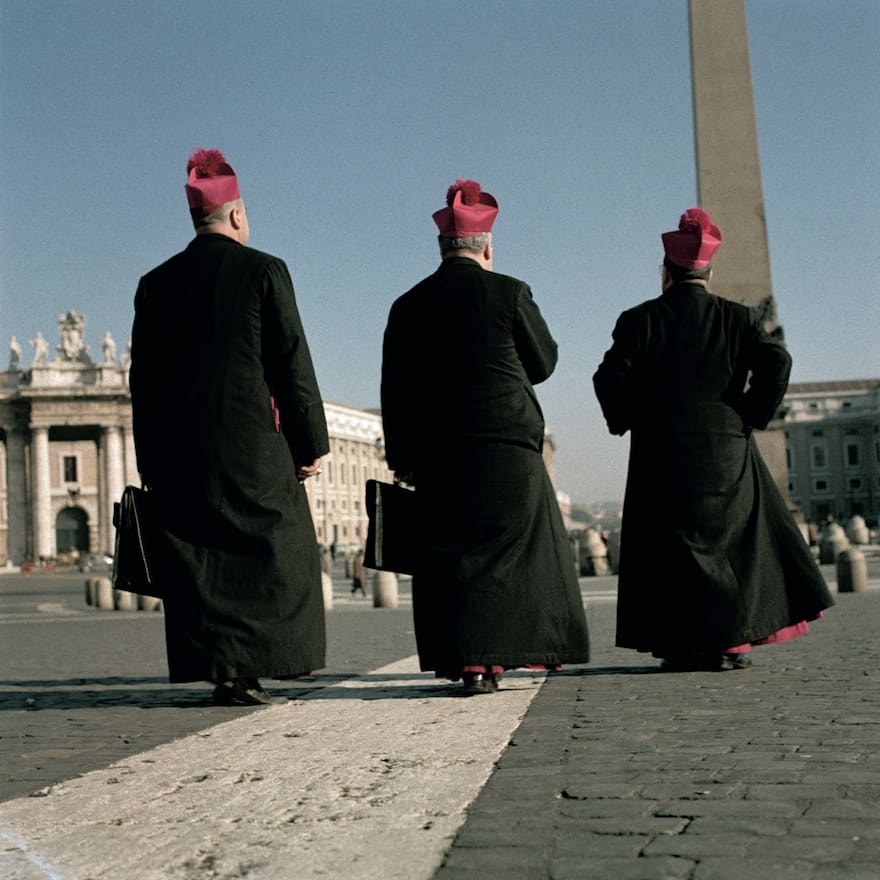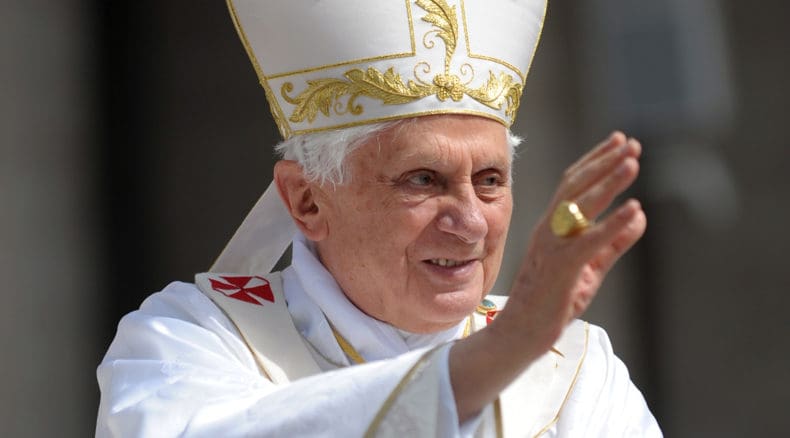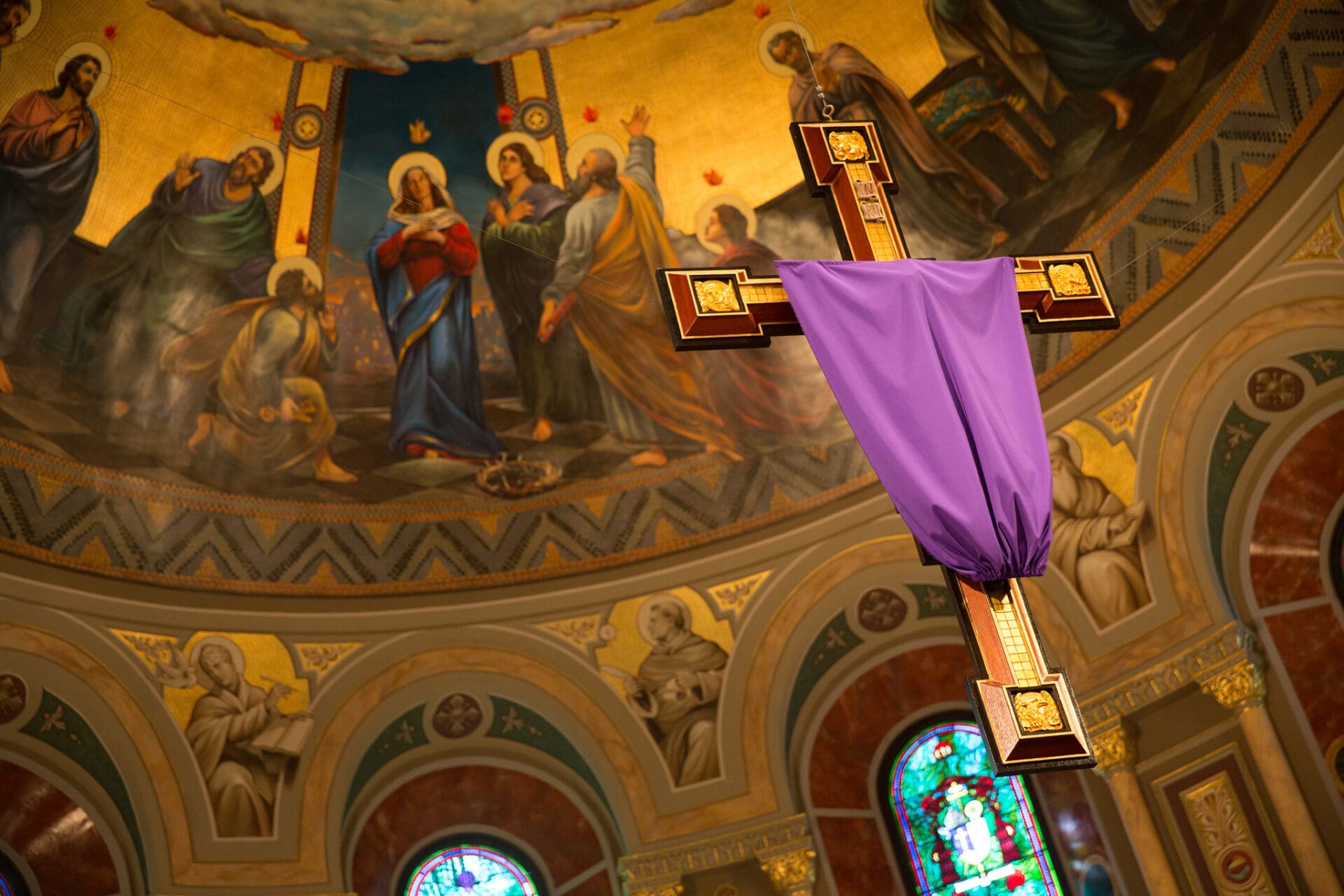Perhaps more than any pope in recent history, Pope Emeritus Benedict XVI revealed himself as profoundly interested in questions relating to the liturgy and its singular importance in the life of the Church. Before, during, and after his eight-year papacy, Pope Benedict has made a number of provocative statements about its pivotal role in the renewal of the Church of today: “The Church’s existence lives from proper celebration of the liturgy and the Church is in danger when the primacy of God no longer appears in the liturgy nor consequently in life.”[1] Likewise, he notes: “The Church stands or falls with the Liturgy. The celebration of the sacred liturgy is at the center of any renewal of the Church.”[2]
“The Church stands or falls with the Liturgy.”
Prior to his assumption of the papal office in 2005, Joseph Ratzinger, as a cardinal and theologian, devoted numerous articles and books to liturgical theology and practical issues relating to the proper celebration of the liturgy in the contemporary Church, including questions of liturgical art, architecture, and music. Benedict’s thinking on liturgical matters displays a remarkable consistency throughout the years and remains fundamentally shaped by one of the chief goals of his theological vision: the proper reception and implementation of the true meaning of the Second Vatican Council as a source of renewal in the Church’s life. In this entry, we will 1) explore Benedict’s analysis of the state of the liturgy leading up to the Second Vatican Council, 2) his views of the Second Vatican Council’s liturgical reform, and 3) his critique of certain trends and developments in the postconciliar era. In the second part of the paper, to be published in a future issue, we will also study 1) Pope Benedict’s solutions to these challenges, known as the “reform of the reform,” and 2) conclude by surveying the liturgical renewal he ushered in during his papacy.

1. Ratzinger’s View of the Preconciliar Liturgy
While Ratzinger is widely known for his rather sharp critiques of liturgical developments after the Council, he knew that the liturgy as celebrated before the Second Vatican Council was no “golden era” but in need of reform. While Ratzinger credits his love of liturgy with his childhood memories participating in Corpus Christi processions and living the liturgical year in his close-knit parish in Bavaria, he does not romanticize the state of the liturgy before the Council. Ratzinger’s main issues with the preconciliar liturgy are best articulated in an image he uses in his preface to his central liturgical work, The Spirit of the Liturgy, where he describes the liturgy as a “painted over fresco” whose original content, clarity, and form have been covered and obscured by certain forms, ceremonies, and rubrics. This image is important and worth quoting at length because it succinctly captures Ratzinger’s analysis of the liturgy before, during, and after the Second Vatican Council:
“We might say that…the liturgy was rather like a fresco [in the early 20th century]. It had been preserved from damage, but it had been almost completely overlaid with whitewash by later generations. In the Missal from which the priest celebrated, the form of the liturgy that had grown from its earliest beginnings was still present, but, as far as the faithful were concerned, it was largely concealed beneath instructions for and forms of private prayer. The fresco was laid bare by the Liturgical Movement and, in a definitive way, by the Second Vatican Council. For a moment its colors and figures fascinated us. But since then the fresco has been endangered by climatic conditions as well as by various restorations and reconstructions. In fact, it is threatened with destruction, if the necessary steps are not taken to stop these damaging influences. Of course, there must be no question of its being covered with whitewash again, but what is imperative is a new reverence in the way we treat it, a new understanding of its message and its reality, so that rediscovery does not become the first stage of irreparable loss.”[3]
We’ll bracket for now the second half of this analysis, where Ratzinger worries about the climactic conditions after the Council that endangered this restoration and focus here on the fact that he did indeed believe the liturgy as celebrated before the council had been overlaid with “whitewash.” Among the elements of this whitewashing of the liturgy in the preconciliar period, Ratzinger notes an excessive focus on the liturgy as rubrics or external ceremonial; a textbook, scholastic approach to liturgy that was concerned with questions of validity and juridical concerns over its theological meaning and true spiritual content; what he refers to as the “wall of Latinity” which prevented a substantial number of the faithful from participation in the liturgy and caused the laity to focus on their own private prayers and devotions and muted the communal nature of the liturgical celebration.[4]
Ratzinger saw the preconciliar liturgy as in a state of fossilization or mummification when it needed to be open to development and change, but always in continuity with its own inner nature and principles. Above all, Ratzinger perceived the liturgical problem as modern man’s loss of contact with the liturgy, diminishing an awareness of it as a rich expression of the content of faith (dogma) and spirituality, and failing to connect how it relates to our daily lives in the world.
For these reasons, Ratzinger was a supporter of the 20th-century liturgical movement, which had as its goal the rediscovery of the central role of the liturgy in the life of the Church as a living whole, a call for deeper, more active participation in the liturgical rites to bridge the gap between liturgy and life, and a deepened liturgical catechesis to better understand and appreciate what the liturgy truly is and does through its rites, prayers, gestures, and postures.
Ratzinger does not romanticize the state of the liturgy before the Council.
Above all, as a proponent of the liturgical movement, Ratzinger stressed the need to get in greater contact with the spirit of the liturgy. He believed any sort of liturgical reform inspired by the liturgical movement should prioritize the values of listening, learning, rediscovering, receiving, and, above all, interiorizing this liturgical spirituality as its starting point.[5]
2. Ratzinger on the Second Vatican Council’s Reform of the Liturgy
Given his support for the main goals and principles of the 20th-century liturgical movement, it should come as no surprise that Ratzinger viewed the Second Vatican Council’s Constitution on the Liturgy, Sacrosanctum Concilium, as the culminating fruit and crowning of that movement’s efforts. His response to the Liturgy Constitution itself is overwhelmingly positive and optimistic about the future liturgical life of the Church. He viewed the Constitution’s recommended reforms as a fulfillment of his desire to remove the “whitewash” of the liturgical fresco by removing certain aspects that had obscured its true meaning and restoring them to their original intent. Among the Council’s recommendations Ratzinger praises in his writings at the time of the Council include: the priority of Sunday over saints’ days in the liturgical year, a focus on simple liturgical structures rather than “overgrown forms” in parts of the liturgy, a greater emphasis on communal celebration, restoration of the liturgy of the word, the call for more active participation of the laity, overcoming the exclusive dominance of Latin through allowance of the vernacular, and a “defrosting of ritual rigidity,” opening the liturgy up to future developments.[6] Despite certain revisionist traditionalist narratives to the contrary, Ratzinger’s praise of these reforms testifies to the fact that they were not merely the concerns of a fringe group of “progressive” liturgists foisted upon the Church—the Liturgy Constitution was approved by the overwhelming majority of the Council Fathers (only 4 votes against vs. 2147 in favor).
The revised Missal is “nothing other than a renewed form of that same Missal to which Pius X, Urban VIII, Pius V and their predecessors have contributed, right from the Church’s earliest history.”
After the Council, the liturgical reform mandated by the Council Fathers was entrusted by Pope Paul VI to the Consilium for the Implementation of the Constitution on the Liturgy. The Consilium was composed of study groups of bishops and top liturgical scholars and worked over the next five years to reform the Church’s liturgical rites, including the Roman Missal and its revised order of Mass (ordo missae) that was promulgated by Paul VI in 1969, coming into effect the first Sunday of Advent that year. On the whole, I would judge that Ratzinger’s attitude to the revised liturgical books is generally positive and appreciative, if more muted in enthusiasm than his earlier writings on the Council’s Constitution. In an interview with the editor of the scholarly journal Communio he stated:
“Lest there be any misunderstanding, let me add that as far as its content is concerned (apart from a few criticisms), I am very grateful for the new Missal, for the way it has enriched the treasury of prayers and prefaces, for the new Eucharistic prayers and the increased number of texts for use on weekdays, etc., quite apart from the availability of the vernacular.”[7]
On the other hand, he has made certain strong criticisms which could be regarded as applying to the revised liturgical books themselves. In particular, he takes issue with the impression that the revised liturgical books appear more as creations of academics in a study group to meet the needs of modern men and women rather than the fruit of living, organic liturgical development: “After the Council…in the place of the liturgy as a fruit of organic development came fabricated liturgy. We abandoned the organic, living process of growth and development over centuries and replaced it—as in a manufacturing process—with a fabrication, a banal on-the-spot product.”[8]
However, Ratzinger seems here to be primarily criticizing the mentality or deficient attitudes accompanying the introduction of the reformed liturgies and errors in its implementation, rather than the reformed liturgy itself. He made clear that the Missal of Paul VI was not a rupture in the tradition, not a “new Mass,” but “nothing other than a renewed form of that same Missal to which Pius X, Urban VIII, Pius V and their predecessors have contributed, right from the Church’s earliest history.”[9]

3. Ratzinger’s Critiques of Postconciliar Developments
Moreover, Ratzinger has written that the post-Vatican II liturgical crisis in the Church has “very little to do with the change from the old to the new liturgical books” and more to do with “a profound disagreement about the very nature of the liturgical celebration.”[10] In an analysis of the postconciliar era, he asserted that, through the reform, “the liturgy has been brought from behind the veils of history to stand before us, fresh in its simplicity and greatness of status,”[11] and that it became more accessible to contemporary believers.[12] Now, in light of this, we will focus rather on Ratzinger’s critiques of the certain postconciliar attitudes and deficiencies in its implementation which negatively impacted the reception of the liturgical reform. He largely saw these aberrations as coming from an excessive emphasis on particular features of the liturgy which caused imbalances, aspects which, while good and noble in themselves, are thrown out of whack when given undue exaggeration. As Ratzinger himself puts it, “in the implementation of the conciliar mandate it was easy for the balance of the conciliar document to be disrupted one-sidedly in a specific direction.”[13] So, for example, while Catholic theology recognizes the Eucharist is both a sacrifice and a meal, after the Council, certain theologians placed undue emphasis on the Eucharist as a communal meal such that its sacrificial dimension was obscured. Outside of its proper context, this exaggerated emphasis on the meal aspect of the Eucharist led to celebrations that reflected an everyday meal among friends rather than the awe-inspiring rite whereby we participate in the one sacrifice of Christ on Calvary. Rather, for Ratzinger, the Eucharist is a meal only because it is first and foremost a sacrifice; it presupposes communion in a sacrifice which has been offered.
Another one of Ratzinger’s closely related concerns centers on the subject of the liturgical celebration. If the Eucharist is reduced to a communal meal on the strictly horizontal plane to foster human values of unity, a feeling of togetherness, and reaffirmation of its own identity, then Ratzinger worries that we are tempted to shift the focus from God-centered celebrations (theocentric) to people-centered celebrations (anthropocentric) in the name of a “pastoral pragmatism,” resulting in a liturgy “constructed entirely for men…, concerned with winning people over or keeping them happy and satisfying their demands.”[14] For Ratzinger, the liturgy is not something that we do, but what God does in us and for us, reconciling us to the Father in the power of the Spirit. Ratzinger sees this local, assembly-centered, anthropocentric shift as the root of a number of related issues in the postconciliar mentality.
“Must every Mass…be celebrated facing the people? Is it so absolutely important to be able to look the priest in the face”
For if the liturgy is principally about meeting the needs of a local congregation, if it is celebrated primarily by and for the people, then liturgical creativity becomes a central goal of the celebration. Rather than receiving the liturgy as a gift we receive from tradition, it becomes a general outline that each local community adapts according to its needs—either by omitting certain prayers or gestures, changing the texts of the prayers, or adding foreign elements into the liturgy that obscure its fundamental meaning. This leads to the impression that the liturgy is “fabricated,” a product of our own making that ultimately only serves as a mirror to our own thoughts, feelings, and concerns instead of opening us to the transcendent Lord who comes to meet us and change us beyond our expectations.
In short, the community risks “celebrating itself” (auto-celebration), muting the fact that the liturgy has a cosmic dimension, leading all of creation into right praise of God, and losing sight of its primary goal: to draw us into Christ’s death and resurrection and thereby share in the richness of God’s triune life. Ratzinger believes this misunderstanding is reinforced ritually by the nearly exclusive practice of celebrating the liturgy ad populum, where the priest faces the congregation. In this practice, in no way called for by the Council itself, Ratzinger wonders: “Must every Mass…be celebrated facing the people? Is it so absolutely important to be able to look the priest in the face, nor might it not be often very salutary to reflect that he is also a Christian and that he has every reason to turn to God with all his fellow-Christians of the congregation and to say together with them ‘Our Father’?”[15]
Forgotten qualities like listening, adoration, and silence are crucial to this fuller understanding of active participation and regrettably absent in many noisy, contemporary celebrations of the liturgy.
This practice doesn’t mean that the priest had his back “to the people” but highlights that the whole congregation, including the priest, faces the same direction, the East, which has symbolic associations with the Lord who comes to meet and transform us. Instead, celebrating ad populum can lead to the impression that the congregation and priest are celebrating Mass as a “circle closed within” when both should be turned in an attitude of profound adoration towards the Lord. He also believes this led to an unintended side effect whereby the priest is tempted to become the center of attention in the liturgy, fulfilling the role of show-master or entertainer, rather than being transparent to the person of Christ.
Another area of Ratzinger’s critiques concerns the understanding of participation in the liturgy. Ratzinger is concerned that the concept of “active participation” called for by the Second Vatican Council has been interpreted one-sidedely as “doing things” in the liturgy (singing, gestures, fulfilling a liturgical ministry) when it is primarily internal and spiritual, being interiorly transformed and taken up into Christ’s paschal journey to the Father. As a result, forgotten qualities like listening, adoration, and silence are crucial to this fuller understanding of active participation and regrettably absent in many noisy, contemporary celebrations of the liturgy. For Ratzinger, as for Romano Guardini, “being” is prior to and foundational for “doing.”
Ratzinger also criticizes certain “rationalistic” and didactic tendencies which construe the call for active participation as a call for everything to be easily accessible or immediately understood, often sacrificing the solemnity and mysterious “otherness” of the liturgy. Simplicity and intelligibility are good in and of themselves, but the liturgy should also cultivate a sense that a reality greater than ourselves is here present among us—the beauty of heaven and the eschatological glory of the Lord are anticipated and rendered present for us, and our liturgies must reflect this. Similarly, even though not immediately, easily comprehensible to many modern believers, he believes Latin still has a role to play in the Church alongside the vernacular as a concrete tie to Catholic tradition and the universal church. The vernacular translations that are used also need not be always immediately accessible or suited to contemporary mentalities but faithful to the original Latin and its theological richness. Closely tied to this development was the desacralization of the liturgy and the loss of the treasury of sacred art and architecture. If the liturgy is simply a human meal designed to foster friendly feelings and human brotherhood, then the ordinary and everyday becomes primary. Rather, for Ratzinger, Christian spaces and music should be truly sacred, that is, consecrated and in some way set apart from our everyday experience and dedicated solely to worship. This would cultivate the sense that the liturgy truly does take us outside of ourselves and transports us into the liturgy of heaven.
In a future issue, Kevin Magas will examine Pope Benedict’s project of the “Reform of the Reform,” his promotion of ars celebrandi and beauty in the liturgy, and his overall desire to “re-Catholilcize” the liturgy today and in the future.
Kevin D. Magas holds an MTS and PhD in theology from the University of Notre Dame. He currently serves as an assistant professor of dogmatic theology and director of intellectual formation for the Liturgical Institute at the University of St. Mary of the Lake/Mundelein Seminary, Mundelein, IL. He lives in Mundelein with his wife and children.
*This is a version of a talk delivered at the Lumen Christi Institute West Suburban Catholic Culture series on Liturgy, October 2020.
Notes:
https://www.praytellblog.com/index.php/2017/10/04/pope-benedict-xvi-on-the-crisis-of-the-church-god-and-the-liturgy/ ↑
Joseph Ratzinger, Preface to Die Heilige Liturgie, quoted by Roberto de Mattei, “Reflections on the Liturgical Reform” in Looking Again at the Question of the Liturgy with Cardinal Ratzinger, ed. Alcuin Reid (Farnborough: Saint Michael’s Abbey Press, 2003), 141. ↑
Joseph Ratzinger, The Spirit of the Liturgy (San Francisco: Ignatius, 2000), 7-8. ↑
See Joseph Ratzinger, Theological Highlights of Vatican II (New York: Paulist Press. Deus Books, 1966; republished in 2009), 130-133. ↑
Mariusz Biliniewicz, The Liturgical Vision of Pope Benedict XVI: A Theological Inquiry (New York: Peter Lang, 2013), 73. ↑
See Ratzinger, Highlights, 32-37. ↑
Ratzinger, Feast of Faith. Approaches to a Theology of the Liturgy (San Francisco: Ignatius Press, 1986), 87. ↑
Joseph Ratzinger, Foreword to Klaus Gamber, La Reforme liturgique en question (Le Barroux: Editions sainte-Madeleine, 1992), 7. ↑
Ratzinger, Feast of Faith, 87. ↑
Ibid., 61. ↑
Ibid., 147. ↑
Joseph Ratzinger, “Review of the Postconciliar Era—Failures, Tasks, Hopes” in Principles of Catholic Theology. Building Stones for a Fundamental Theology (San Francisco: Ignatius Press, 1987), 367-78, at 370. ↑
Joseph Ratzinger, “Fortieth Anniversary of the Constitution on the Sacred Liturgy,” in Collected Works, XI. Translated by Kenneth Baker, S.J., and Michael J. Miller. (San Francisco, CA: Ignatius Press, 2014), 575. ↑
Joseph Ratzinger, “Eucharist and Mission,” in Collected Works, XI:332. ↑
Joseph Ratzinger, “Catholicism after the Council,” trans. P. Russell, The Furrow 18 (1967): 11-12. ↑


